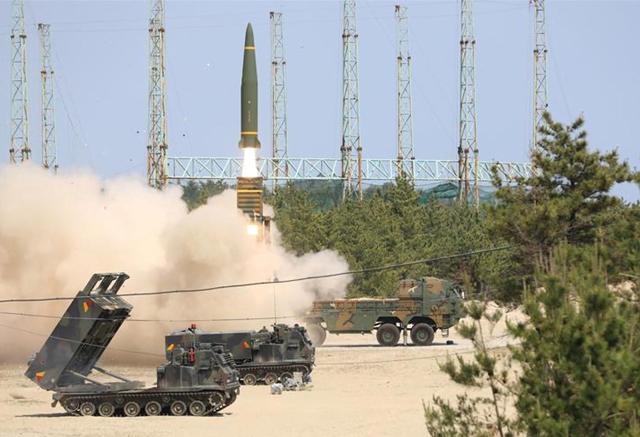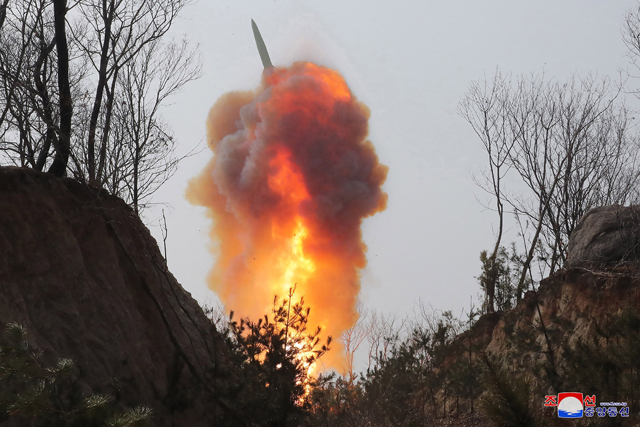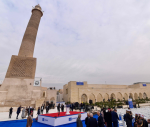You are here
North Korea fires short-range ballistic missile
By AFP - Mar 19,2023 - Last updated at Mar 19,2023

A woman walks past a television showing a news broadcast with file footage of a North Korean missile test, at a railway station in Seoul, on Sunday (AFP photo)
SEOUL — North Korea fired a short-range ballistic missile on Sunday, Seoul's military said, the fourth show of force in a week as South Korea and the United States stage major military drills.
Seoul and Washington have ramped up defence cooperation in the face of growing military and nuclear threats from the North, which has conducted a series of increasingly provocative banned weapons tests in recent months.
South Korea and the United States are in the middle of 11 days of joint drills known as Freedom Shield, their largest in five years.
North Korea views all such exercises as rehearsals for invasion and has repeatedly warned it would take "overwhelming" action in response.
"Our military detected one short-range ballistic missile fired from around the Tongchang-ri area in North Pyongan province at 11:05 am [02:05 GMT] towards the East Sea," South Korea's Joint Chiefs of Staff (JCS) said, referring to the body of water also known as the Sea of Japan.
The missile flew 800 kilometres and was under analysis by US and South Korean intelligence, the JCS said in a statement, calling the launch "a serious provocation" that violated UN sanctions.
"Our military will maintain a solid readiness posture based on its ability to overwhelmingly respond to any provocation by North Korea, while carrying out intensive and thorough combined exercises and drills," it said.
Tokyo also confirmed the launch, with Deputy Defence Minister Toshiro Ino telling reporters Japan had “lodged a vehement protest to and strongly condemned [North Korea] through our embassy in Beijing”.
The US military’s Indo-Pacific Command condemned the launch, saying it highlighted “the destabilising impact” of North Korea’s banned weapons programmes.
South Korea’s defence ministry said hours after the launch it had staged joint air drills with the United States featuring at least one US B-1B long-range bomber.
The drills also involved South Korean F-35A stealth fighter jets and US F-16 fighters and took place as part of the Freedom Shield exercise. The exercise had “greatly enhanced the allies’ interoperability... and wartime capabilities”, the ministry said in a statement.
‘War maniacs’
The latest launch came a day after North Korean state media reported that more than 800,000 young North Koreans had volunteered to join the army to fight “US imperialists”.
The young volunteers were determined to “mercilessly wipe out the war maniacs” and joined the army to “defend the country”, the Korean Central News Agency (KCNA) said.
On Thursday, Pyongyang test-fired its largest and most powerful intercontinental ballistic missile, the Hwasong-17, its second ICBM test this year. It described the launch as a response to the “frantic” US-South Korea drills.
That launch drew condemnation from G-7 foreign ministers Sunday, saying “North Korea’s reckless behaviour demands a swift and unified response by the international community, including further significant measures by the UNSC”.
The UN Security Council is expected to hold an emergency meeting Monday over the ICBM launch at the request of the United States and Japan, Yonhap news agency reported.
In a statement carried by KCNA on Sunday, the North’s foreign ministry “strongly” warned the US and other countries about including “legitimate self-defensive countermeasures of the DPRK for the discussion of the UNSC.” DPRK is the acronym of North Korea’s official name.
In a separate statement, the foreign ministry also slammed the US ambassador to the UN Linda Thomas-Greenfield over a recent UN meeting over the North’s human rights abuses.
“If the US is so worried about the ‘human rights situation’ in the DPRK, it should explain why it is so obsessed with the implementation of the most unethical sanctions,” the statement said, warning the moves will result in “irreversible security instability” for the United States.
More missiles
Analysts previously said North Korea would likely use the drills as an excuse to carry out more missile launches and perhaps even a nuclear test.
The ICBM launch followed two short-range ballistic missiles on Tuesday and two strategic cruise missiles fired from a submarine last Sunday.
The recent flurry of aggression by Pyongyang has pushed Seoul and Tokyo to mend fences over historical disputes and try to boost security cooperation.
Just hours after the ICBM was fired on Thursday, South Korean President Yoon Suk-yeol arrived in Japan for the first full-scale leaders’ summit between the countries in 12 years.
Yang Moo-jin, a professor at the University of North Korean Studies in Seoul, said the recent missile launches had several purposes, including protesting against the joint drills as well as testing trilateral responses from South Korea, the United States and Japan.
North Korea declared itself last year an “irreversible” nuclear power and leader Kim Jong-un recently called for an “exponential” increase in weapons production, including tactical nuclear weapons.
Kim also ordered the North Korean military this month to intensify drills to prepare for a “real war”.
Related Articles
SEOUL — North Korea fired a volley of missiles on Wednesday, including possibly its largest intercontinental ballistic missile, just hours a
SEOUL — North Korea fired two ballistic missiles Monday, its second weapons test in 48 hours, which Pyongyang said was a drill for a rocket
SEOUL — North Korean leader Kim Jong-un led two days of military drills “simulating a nuclear counterattack”, including the launch of a ball


















